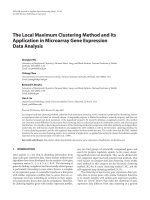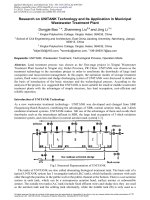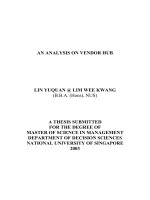SLIDE TOPIC: AN ANALYSIS ON UBER’S PRODUCT DEVELOPMENT PROCESS AND ITS APPLICATION IN VIETNAM
Bạn đang xem bản rút gọn của tài liệu. Xem và tải ngay bản đầy đủ của tài liệu tại đây (571.22 KB, 30 trang )
TOPIC: AN ANALYSIS ON UBER’S PRODUCT DEVELOPMENT PROCESS AND ITS
APPLICATION IN VIETNAM
Candidate Nam: Tran Phuong Anh
Student ID: 1211150014
OUTLINE
1. Stage – Gate model
2. Introduction of Uber
3. Case of UberPOP in Netherlands
4. Lesson learnt from Uber
1. Stage – Gate model
1. Stage-Gate model
• Karl T. Ulrich and Steven D. Eppinger’s model:
- Better to applied for tangible products
- Focus on product design
- Functional - oriented
Figure 1.1: Key activities and responsibilities of different functions within organization (Ulrich and Eppinger 2012)
1. Stage – Gate model
• Philip Kotler’s model
- Focus on marketing perspective of the product
- Does not include the information on how the product would be evaluated
Idea Generation
Idea Screening
Commercialisation
Test Marketing
Figure 1.2: New Product Development (Kotler 2006)
Concept Development
Marketing Strategy
and Testing
Development
Product Development
Business Analysis
1. Stage – Gate model
• Robert Cooper’s Stage – Gate model:
Figure 1.3: The typical Stage - Gate model (Cooper 2001)
1. Stage – Gate model
• Robert Cooper’s Stage – Gate model:
- Most likely to make alteration in order to apply to the practice of the company thanks to its generalization
characteristic
- Emphasize the importance of the “gates”, which help to decide whether to cancel the project or not after each “stage” ->
save efforts and money
2. Introduction of Uber
Picture 1.1: How Uber work (Armin Laidre)
2. Introduction of Uber
• Uber’s most popular sevices: UberX, UberBlack
• Uber launched in Vietnam in June 2014
3. Case of UberPOP in Netherlands
3. Case of UberPOP in Netherlands
• UberPOP
- First launched in Netherlands
- Function as “carpool” service
Scoping
Building Business Case
Preliminary market assessment
Analysis on user’s needs and wants
Preliminary technical assessment
Competitive advantage
Preliminary financial and business assessment
Technical assessment
3. Case of UberPOP in Netherlands
Dutch market analysis:
- Total revenue generated is high
- People prefer using taxi due to the flexibility in time and route
Figure 3.1: Dutch government cost per passenger (Davids et al. 2014)
3. Case of UberPOP in Netherlands
Uber’s competitive advantage:
- Low Price
- Effective transportation solution
Average number of person in car
UberPOP average
1.9
Netherland average 1.4
0.45
0.33
0.12
0.1
Figure 3.2: Netherlands's average number of person in car (Davids et al. 2014)
3. Case of UberPOP in Netherlands
• Training drivers:
30%
40%
5%
25%
Figure 3.3: Proportion of UberPOP's driver education (Davids et al. 2014)
Bachelor
MBO
Other
Master
3. Case of UberPOP in Netherlands
• Pricing
Figure 3.4: Uber's pricing overview (Leeuwen 2014)









